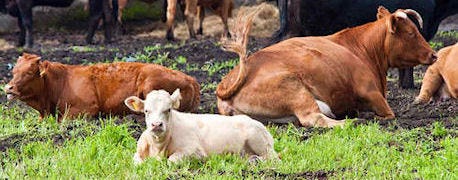
Cattle and calves on feed for slaughter market in the United States for feedlots with capacity of 1,000 or more head totaled 10.368 million head on July 1, 2013. The inventory was 3.2% below July 1, 2012. Number of cattle in lots is a tad fewer than average trade expectations before the report.

Higher than expected June marketings pull the July 1 on-feed inventory below expectations, despite slightly larger than expected placements in Cattle on Feed report
The inventory included 6.53 million steers and steer calves, down 3% from the previous year. This group accounted for 63% of the total inventory. Heifers and heifer calves accounted for 3.78 million head, down 4% from 2012. The relatively larger decline in heifer inventories could be confirming evidence that ranchers in parts of the country where grazing conditions have improved maybe saving a few more heifers for cow herd expansion.
Placements in feedlots during June totaled 1.59 million, 5% below 2012. The tally, from USDA surveys, is a tad higher than traders expected. Net placements were 1.52 million head. During June, placements of cattle and calves weighing less than 600 pounds were 315,000, 600-699 pounds were 232,000, 700-799 pounds were 415,000 and 800 pounds and greater were 625,000.
Marketings of fed cattle during June totaled 1.90 million, 4% below 2012. Marketings for the month of June are the lowest since the series began in 1996. Still, June marketings were about 34,000 higher than expected. June 2012 had one less weekday this year, compared with 2012.
.jpg?width=550&auto=webp&quality=80&disable=upscale)
Better grazing delays placements, lures herd expansion
Before the report some traders expected that improved pasture conditions in the eastern half of the nation and portions of the central and northwestern regions, compared with a year ago, could have allowed cattle producers and ranchers there to hang onto their young animals longer, which may have led to fewer animals entering the feed yards. If that happened, it did not occur to the degree the trade expected. One possible reason is recent gains in feeder cattle prices enticed cow-calf producers to sell.
Ranchers and farmers may retain some of the young females to add to their breeding herds where pastures, hay stocks and water supplies are sufficient to allow them to do so. Time will give a clearer picture of potential herd expansion
The exceptions for better pasture conditions include the western areas of the Plains and southwestern U.S. where pastures remain poor throughout the spring and have deteriorated even further in recent weeks.
Flow of cattle north from Mexico slows
Imports of young cattle from Mexico are down by nearly half from 2012 at about 519,000 head as of the week-ended July 13, compared with 948,000 a year ago. The drought in Mexico in 2011 and 2012 caused ranchers there to move more animals off the parched pastures and ship them north to feedlots in the U.S.
Persistently negative cattle feeding margins continue to plague feedlot operators. To get back in the black, feedlots need lower feed costs. Lower feeder cattle prices would also help feedlot margins. However, cattle feeders have a habit of bidding all their profits into feed cattle prices—and sometimes more.
Monday USDA will report U.S. frozen pork and beef stocks as of June 30. Traders expect stocks to be down modestly from the end of May, but up a few million pounds from their respective year-ago figures and at new record highs for that date. Both categories are expected to show double-digit increases from their respective five-year averages.
About the Author(s)
You May Also Like




